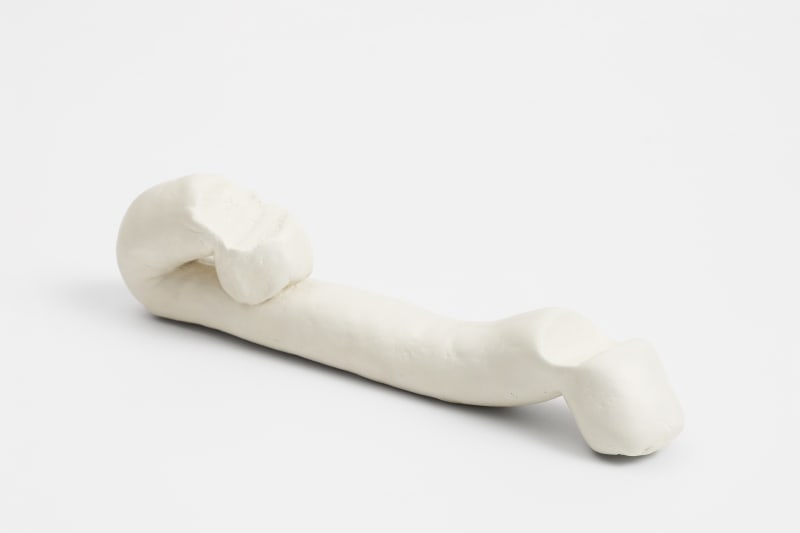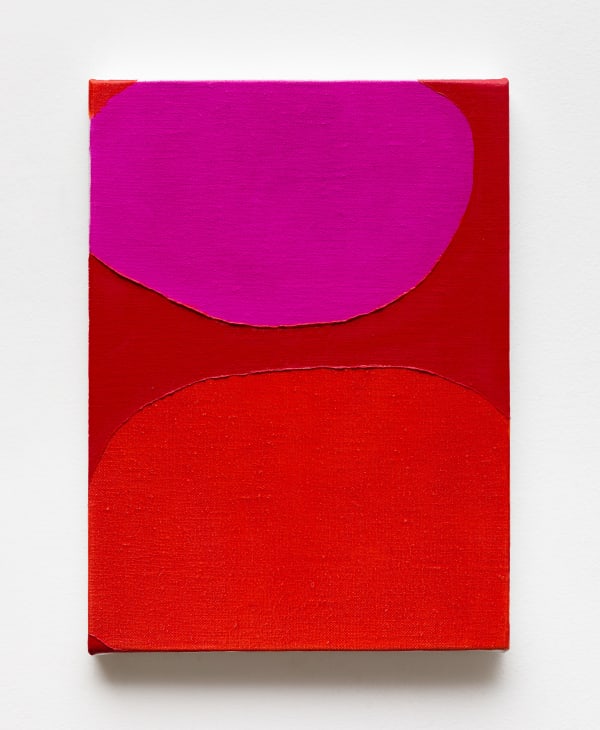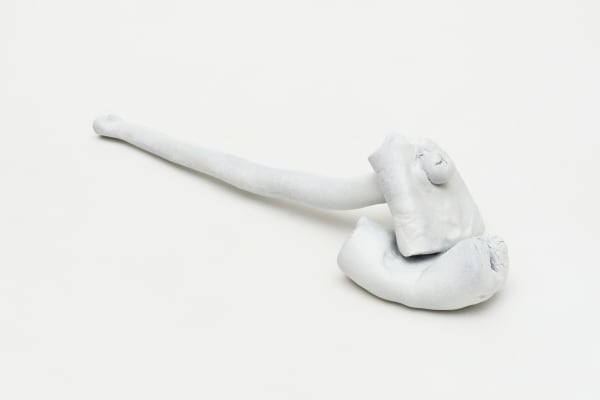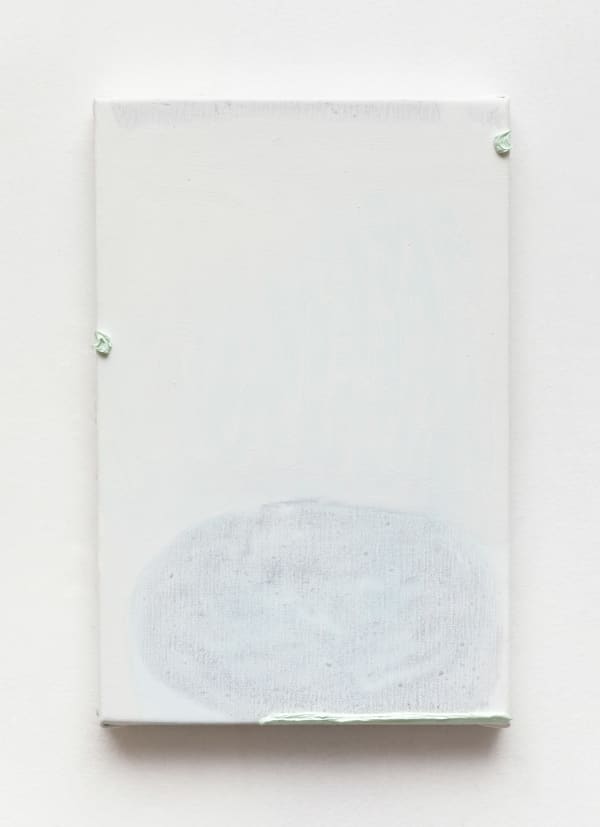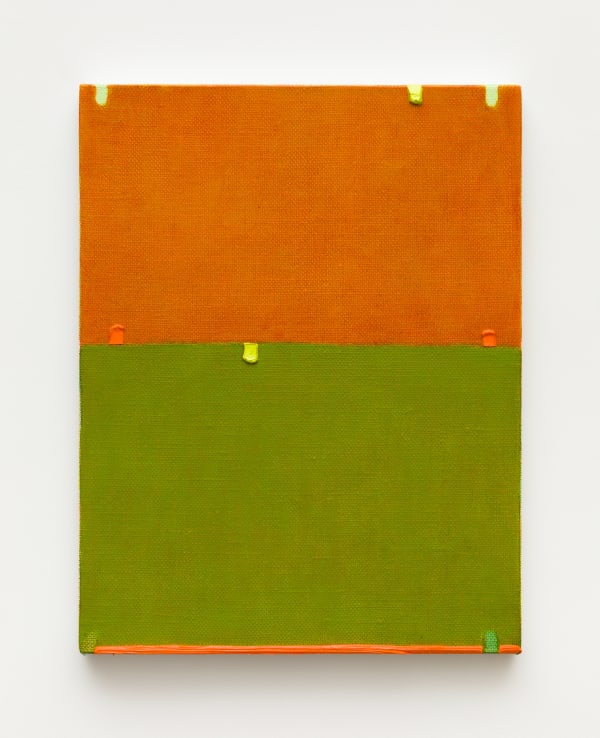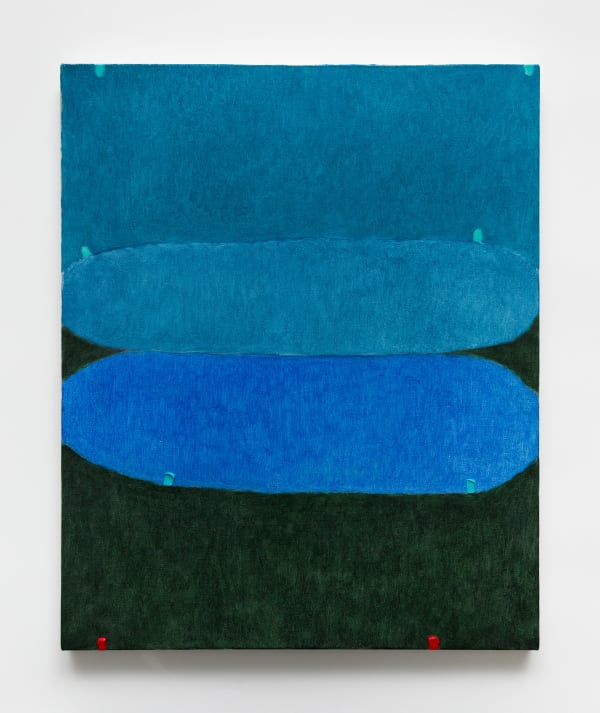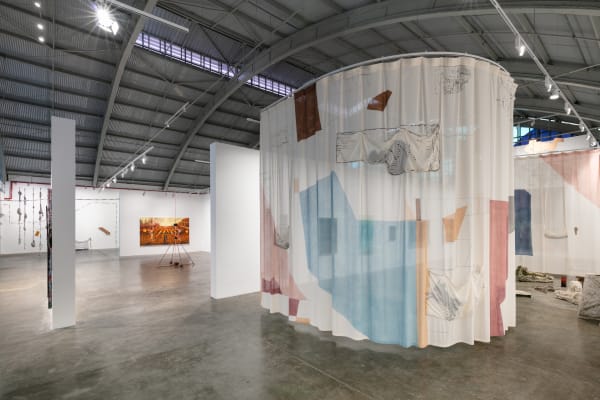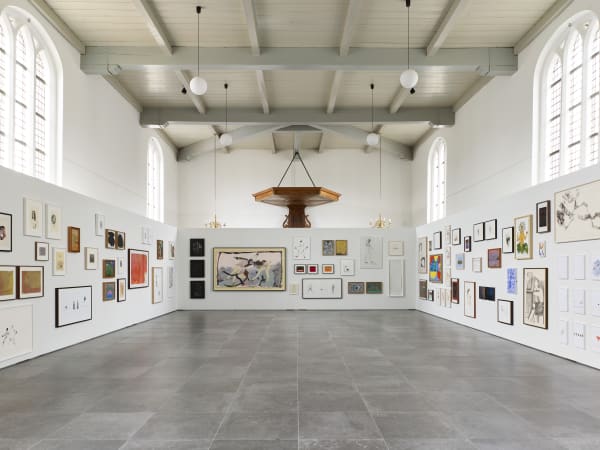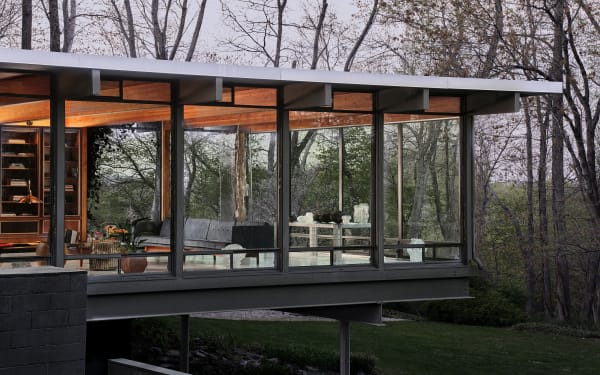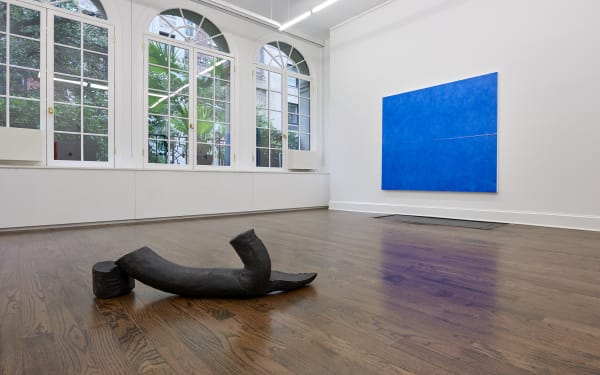I use somewhat the same strategy in physical space and on paper [...] It’s abstract, but it’s an element in space that obeys a certain strategy, the same one I use in drawing.
– Paulo Monteiro
Paulo Monteiro continues his ongoing reconciliation of the dual forms of painting and sculpture by constructing a narrative between them. Continuously exploring the margins and limits of shape, Monteiro utilizes negative space as a medium in order to make his paintings feel like sculptures and his sculptures feel like paintings. His palette oscillates between predominantly cool and warm tones, dark blues, and a variety of reds that at once create an interlocking depth and almost strident contrast; his whites and grays offer a tactility akin to that of his drawings.
Monteiro began his artistic practice in 1977 by precariously assembling found wood into compositions that simultaneously suggest motion and collapse, focusing on the expression of the material. He also created comic strips in a style influenced by cartoonists such as Robert Crumb and George McManus and the renowned Brazilian caricaturist Luiz Sá.
Between 1983 and 1985, he was an integral part of the group Casa 7 alongside Carlito Carvalhosa, Fábio Miguez, Nuno Ramos, and Rodrigo Andrade. Together, these artists participated in exhibitions at MAC – São Paulo, MAM-RJ and the 18th São Paulo Biennial in 1985, bringing Neo-Expressionism to the forefront of the São Paulo art scene. In the late 1980s and the early 2000s, Monteiro immersed himself in his sculptural practice. His return to painting over a decade ago brought a new level of consciousness to his work.
In the last decade, Monteiro has turned to pieces of rope, scraps of wood, cardboard, aluminum strips, and clay for the foundations of his sculptures. When using clay, he splays clay slabs open, dissects, and squeezes them with his hand until an animated interior reveals itself. The same conceptual unfolding process is applied to his painting technique, with inversions and constructions operating from the center of the painting. Paint is pushed to the edges of the canvas, creating forceful, physical borders. It is common that two paintings made with the same strokes appear different, depending on the canvas’s color, shape, and scale, which vary greatly. While a malleable physicality suffuses through his works, Monteiro has also been preoccupied with exploring the possibility of the line for most of his career, manifested as strokes in his work on paper, relief in his paintings, and cuts in his sculptures. His lines are never completely straight, nor do they follow a logic; in a Deleuzeian sense, they are pulling in both directions at once, existing between the affirmation and negation of space.
This radical plasticity in relation to the viewer led Monteiro to his “constellations” – configurations of his paintings and sculptures – which deal with the physicality of the object in relation to the artist and viewer, much like one of Willys de Castro’s Active Objects. It is through the careful positioning of the negative space that these “constellations” take on form. Monteiro also achieves this through his sculptures formed by the negative imprint of his hand and fingers molded in clay and later cast in bronze or lead. His subject here is the interior life and inner drive of objects and, in his words, aims to “bring life to something lifeless.”
Paulo Monteiro (b. 1961, São Paulo, Brazil) lives and works in São Paulo.
The artist’s works have been featured prominently in exhibitions such as Ao redor da distância, Mendes Wood DM, São Paulo (2024); The Color of Distance, Mendes Wood DM, Brussels (2024); Paulo Monteiro, Mendes Wood DM Archipelago, Germantown (2023); Undefined Inclusions, Pace Gallery, New York (2023); Paulo Monteiro: Linha do Corpo, Instituto Ling, São Paulo (2023); The Middle Distance, Zeno X Gallery, Antwerp (2022);Colors without a place, Tomio Koyama, Tokyo (2022); Paulo Monteiro: The Two Sides of An Empty Line, Lévy Gorvy, New York (2021); The Empty Side, Zeno X, Antwerp (2018); Coleção MAC Niterói: arte contemporânea no Brasil, MAC Niterói, Rio de Janeiro (2017); The outside of distance, MISAKO & ROSEN and Tomio Koyama Gallery, Tokyo (2017); Building Material: Process and Form in Brazilian Art, Hauser & Wirth, Los Angeles (2017); The inside of distance, Office Baroque, Brussels (2016); The inside of distance, Mendes Wood DM, São Paulo (2015); Casa 7, Pivô, São Paulo (2015); Empty House Casa Vazia, Luhring Augustine, New York (2015); Paintings on Paper, David Zwirner, New York (2014); Where Were You, Lisson Gallery, London (2014); 22nd São Paulo Art Biennial (1994) and 18th São Paulo Art Biennial (1985).
His works are in numerous permanent collections, such as Museum of Modern Art (MoMA), New York; Museu de Arte Moderna de São Paulo (MAM-SP), São Paulo; Pinacoteca do Estado de São Paulo, São Paulo; Museu de Arte Contemporânea; de São Paulo (MAC-SP), São Paulo; Museu de Arte Moderna do Rio de Janeiro (MAM-RJ), Rio de Janeiro; Museu de Arte Contemporânea de Niterói (MAC Niterói), Rio de Janeiro; Start Museum, Shanghai.
-
 Untitled | Sem título, 2023
Untitled | Sem título, 2023 -
 Untitled/ Sem título, 2023
Untitled/ Sem título, 2023 -
 Untitled, 2022
Untitled, 2022 -
 Untitled, 2017
Untitled, 2017 -
 Sem título, 2012
Sem título, 2012 -
 Untitled , 2019
Untitled , 2019 -
 Untitled, 2018
Untitled, 2018 -
 Untitled, 2020
Untitled, 2020 -
 Untitled, 2019
Untitled, 2019 -
 Untitled , 2020
Untitled , 2020 -
 Untitled | Sem título, 2022
Untitled | Sem título, 2022 -
 Untitled | Sem título, 2022
Untitled | Sem título, 2022 -
 Untitled, 2022
Untitled, 2022 -
 Untitled, 2022
Untitled, 2022 -
 Untitled, 2020
Untitled, 2020 -
 Untitled, 2020
Untitled, 2020 -
 Untitled / Sem título, 2020
Untitled / Sem título, 2020 -
 Untitled / Sem título, 2020
Untitled / Sem título, 2020 -
 Untitled / Sem título, 2020
Untitled / Sem título, 2020 -
 Untitled , 2020
Untitled , 2020 -
 Untitled / Sem título, 2020
Untitled / Sem título, 2020 -
 Untitled / Sem título, 2020
Untitled / Sem título, 2020 -
 Untitled / Sem título, 2017/2018
Untitled / Sem título, 2017/2018 -
 Untitled / Sem título, 2022
Untitled / Sem título, 2022 -
 Untitled | Sem título, 2023
Untitled | Sem título, 2023 -
 Untitled/ Sem título, 2022
Untitled/ Sem título, 2022 -
 Untitled/ Sem título, 2022
Untitled/ Sem título, 2022 -
 Untitled/ Sem título, 2016 - 2017
Untitled/ Sem título, 2016 - 2017 -
 Untitled/ Sem título, 2021
Untitled/ Sem título, 2021 -
 Untitled/ Sem título, 2021
Untitled/ Sem título, 2021 -
 Untitled/ Sem título, 2022
Untitled/ Sem título, 2022 -
 Untitled/ Sem título, 2022
Untitled/ Sem título, 2022 -
 Untitled/ Sem título, 2022
Untitled/ Sem título, 2022 -
 Untitled/ Sem título, 2022
Untitled/ Sem título, 2022 -
 Untitled/ Sem título, 2022
Untitled/ Sem título, 2022 -
 Untitled/ Sem título, 2022
Untitled/ Sem título, 2022 -
 Untitled/ Sem título, 2022
Untitled/ Sem título, 2022 -
 Untitled/ Sem título, 2022
Untitled/ Sem título, 2022 -
 Untitled/ Sem título, 2022
Untitled/ Sem título, 2022 -
 Untitled | Sem título, 2025
Untitled | Sem título, 2025 -
 Untitled/ Sem título, 2022
Untitled/ Sem título, 2022 -
 Untitled/ Sem título, 2000
Untitled/ Sem título, 2000 -
 Untitled/ Sem título, 2023
Untitled/ Sem título, 2023 -
 Untitled/ Sem título, 2023
Untitled/ Sem título, 2023 -
 Untitled/ Sem título, 2023
Untitled/ Sem título, 2023 -
 Untitled | Sem título, 2023
Untitled | Sem título, 2023 -
 Untitled/ Sem título, 2023
Untitled/ Sem título, 2023 -
 Untitled/ Sem título, 2022
Untitled/ Sem título, 2022 -
 Untitled, 2022
Untitled, 2022 -
 Untitled | Sem título, 2023
Untitled | Sem título, 2023 -
 Untitled/ Sem título, 2023
Untitled/ Sem título, 2023 -
 Untitled/ Sem título, 2023
Untitled/ Sem título, 2023 -
 Untitled/ Sem título, 2023
Untitled/ Sem título, 2023
-
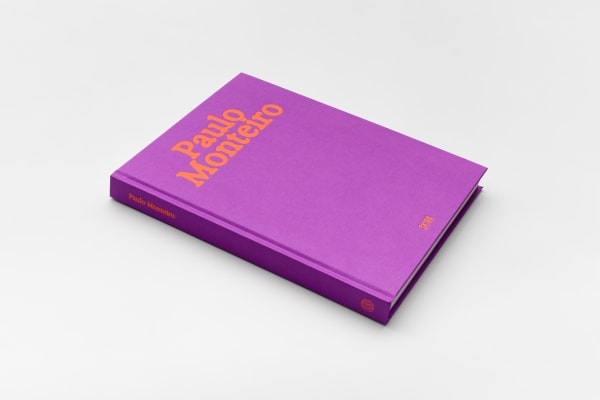
Paulo Monteiro
Germano Dushá and Yann Chateigné Tytelman, 2024 Read more -

Paulo Monteiro: o interior da distância
Kiki Mazzucchelli e Tiago Mesquita, 2015Hardcover, 208 pagesRead more
Publisher: Cobogó
ISBN: 9788560965861
Dimensions: 18 x 24 cm -
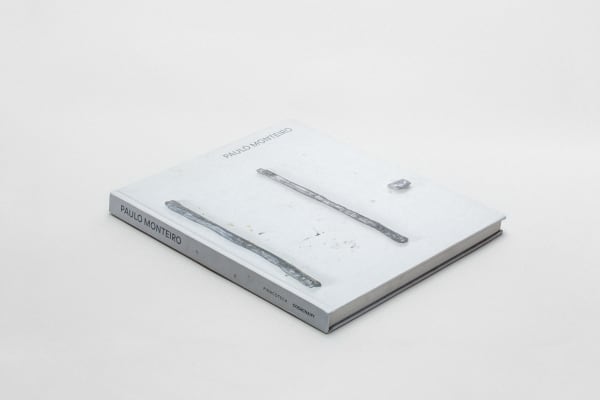
Paulo Monteiro
Alberto Tassinari, Paulo Venancio Filho, Taísa Palhares and Rodrigo Andrade, 2009Hardcover, 216 pagesRead more
Publisher: Cosac & Naify
ISBN: 8575037625
Dimensions: 28.4 x 24.2 x 1.8 cm
Sign up to our newsletter to receive the latest updates about Paulo Monteiro and the gallery
* denotes required fields
We will process the personal data you have supplied to communicate with you in accordance with our Privacy Policy. You can unsubscribe or change your preferences at any time by clicking the link in our emails.

